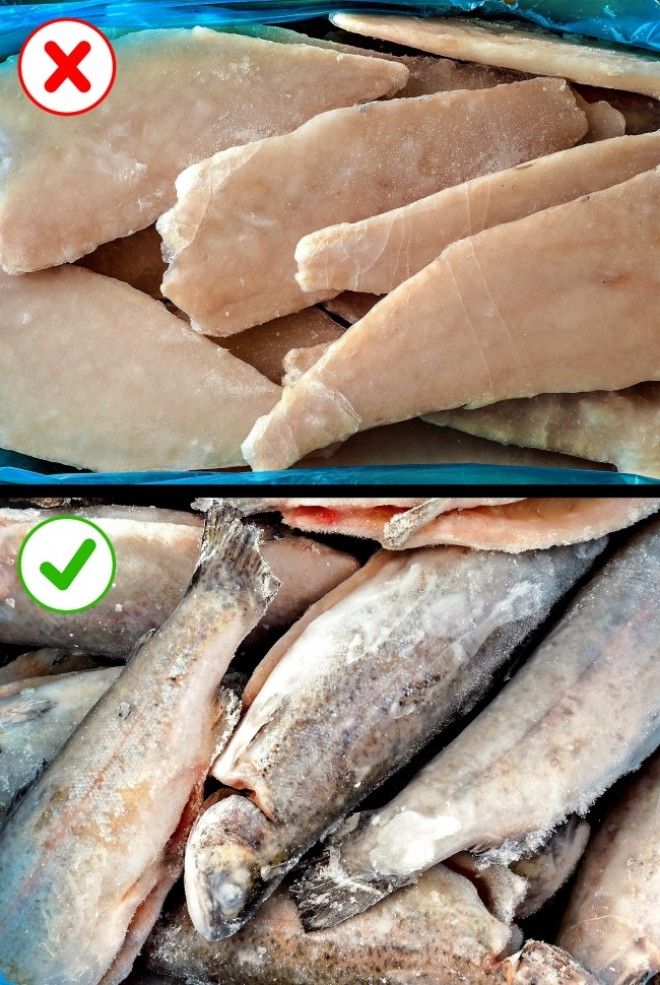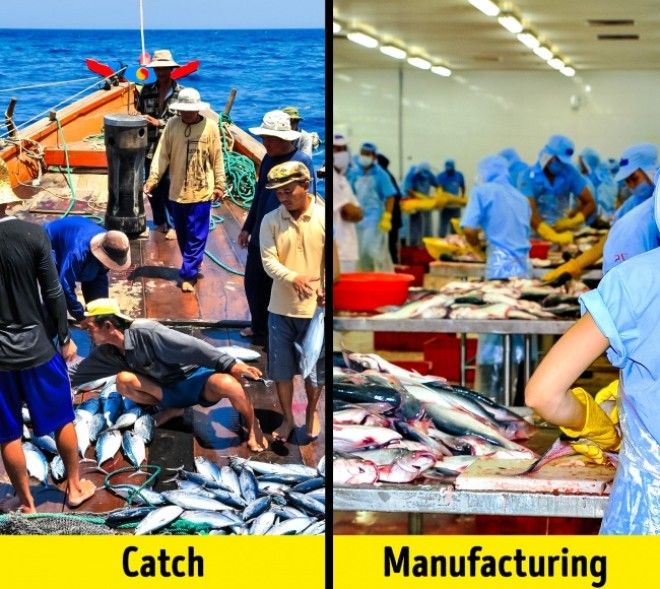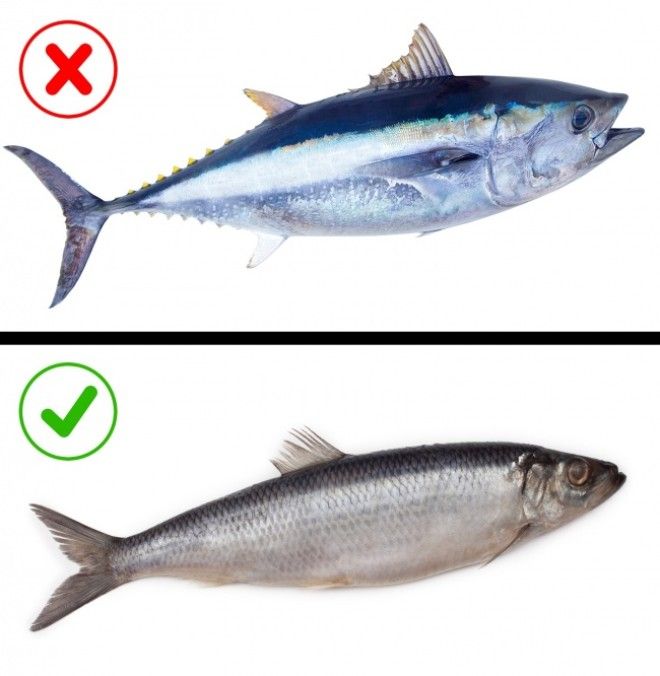There are many myths and lot of speculation when it comes to buying fish. These beliefs often stand in the way of making the right buying choice.
1. Chilled or frozen?

Chilled fish (the kind that lies on ice in stores) is just fresh fish that is cooled down to a certain temperature right after it’s caught. You should know three things about chilled fish:
- Almost all chilled fish is from aquaculture (which means that it is grown artificially on fish farms).
- The storage time for these fish is no more than 12 days.
- It happens often that previously frozen fish is thawed out and sold as chilled fish.
This is why, before you buy the fish, you should ask the salespeople where it was caught. The further the place, the higher that chance that this fish is previously frozen. For example, a lot of salmon is imported from Chile, and of course, it has to be transported frozen when being shipped to other countries. So, if you are offered fresh salmon from Chile, unfortunately, this is a scam.
Another important factor that you should keep in mind is the size of the fish. A fish that is grown artificially is full of growth hormones and antibiotics. So, the bigger the fish, the higher the risk. Whenever possible, buy the smaller fish.
2. What is the difference in taste and composition between frozen and fresh fish?

A Norweigan research group conducted a series of experiments and came to the conclusion that frozen fish is just as rich in vitamins and other nutrients as fresh fish. Frozen fish may taste drier than fresh, but it definitely doesn’t contain any parasites, whereas the fresh kind might. Of course, this only works for the fish that has been frozen and stored in the proper way.
If the fish is strangely shaped (like in the photo, for example) this doesn’t mean that the quality is bad. Sometimes it’s frozen right on the ship, so it’s gets deformed. A bad sign is when frozen fish is stuck together, this might mean that it was thawed out and then re-frozen again. In order to check how fresh a piece of fish is, stick a hot knife into it and smell it. If the smell is bad, this is proof that the fish was frozen after it had already gone bad.
By the way, if you want to keep the fish vitamin and nutrient rich, you should defrost it in the fridge and cook it right after.
3. Fillet or the whole fish?

According to the data provided by Oceana, only about 20% of all fish in stores is fake, and the easiest kind to fake is a fillet. For example, pollock is often sold under the guise of more expensive codfish. So, if you can choose, you should pick the whole fish. Another argument against buying fillet is the chemical mixture that some manufacturers keep it in to get rid of the bones.
If you decide to buy fillet anyway, buy the kind with skin, but before you go to the store, make you sure you know what the skin of different kinds of fish looks like. For example, codfish is grey with a green shade and a dark strip along the body.
4. How much frost should be on the fish and what might it indicate?

According to the law, the volume of the frost shouldn’t be more than 5% of the weight of the fish, but unfortunately, the information on the package is not always true. Hit the fish on something solid — if you notice cracks on the ice, then there is definitely more than 5% frost.
The way the ice looks can tell a lot about the quality of the fish. If there are cracks and clouds on the surface of the ice, it means that the fish was frozen and unfrozen many times. If the ice is yellow, it means that the fish is not fresh.
5. What to look for on the package?

Since 2016, in many countries around the world, there has been a law which makes manufacturers put information about the place where the fish was caught and processed on the packaging. This information is especially important if you are buying fillet, because if the place where it was caught is far away from the place where the manufacturer is located, it means that the fish was frozen when it was transported to the factory, then unfrozen and made into a fillet, and then frozen again. The quality of this type of product, can’t be good.
Also, the package should have information about the contents. Choose a product that has nothing but fish and water. There can be polyphosphate added which keeps the water in the fish to make them weigh more.
6. How to recognize polyphosphate in fish?

Many people have been in a situation when they unfroze the fillet and had about two times less of the fish than when they bought it. This artificial increase of weight is caused not only by the ice but sometimes by polyphosphate which keeps water in the muscles of the fish. If the package doesn’t say that the product contains this chemical, you can recognize it by the gloss on the surface. When you fry fish that contains polyphosphate, it becomes foamy and grey.
7. Which harmful chemicals may be found in fish?

Fish might contain many other dangerous chemicals besides polyphosphate. Pangasius, catfish, and tilapia which are all grown in the Mekong River (one of the dirtiest rivers in the world) often contain such chemicals. Tests of Vietnamese fish also show that they have high levels of mercury, ammonia, and antibiotics. Aside from these chemicals, the tests found biogenic amines in the fish (these are the chemicals that appear because of improper storage). The most dangerous of the amines is histamine.
8. Which fish is it better not to buy?

Besides the Vietnamese fish, there are other kinds (both wild and farm-grown) which you shouldn’t eat at all. The problem with the wild kind is a high level of mercury (by the way, fish is the most common reason for mercury poisoning). The older and bigger a fish is, the more mercury it contains. The most poisonous kinds of fish are swordfish, shark, tuna, king mackerel, and orange roughy.
The problems with aquaculture can be just as bad. There are a low level of nutrients available in these fish farms caused by their poor diet and the environment. Additionally, farm-grown salmon contains less good fats that the wild kind. There is also a high chance that farm-grown fish has growth hormones and antibiotics. The most popular kinds of fish which are grown in farms are salmon, carp, catfish, sea bass, dorade, pangasius, tilapia, and sole.
Of course, you might be asking the question: what do I eat then? The best fish to choose would be herring, pollock, hake, saury, or sardines. If you want salmon, look for coho salmon. The fish mentioned above are not grown in farms, and they are least likely to be contaminated with mercury.

